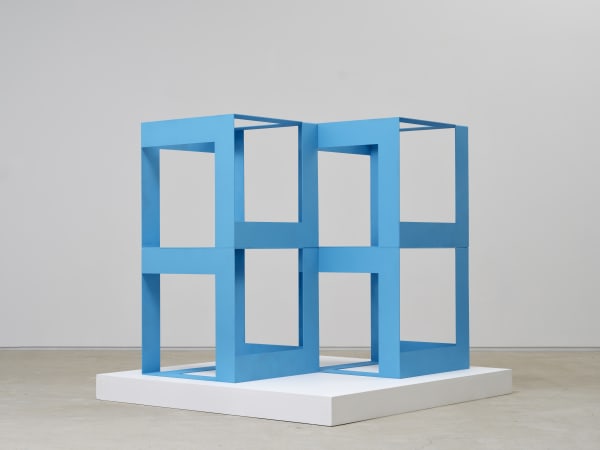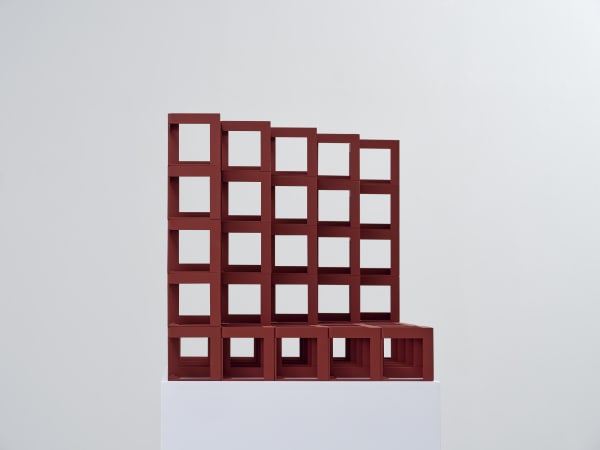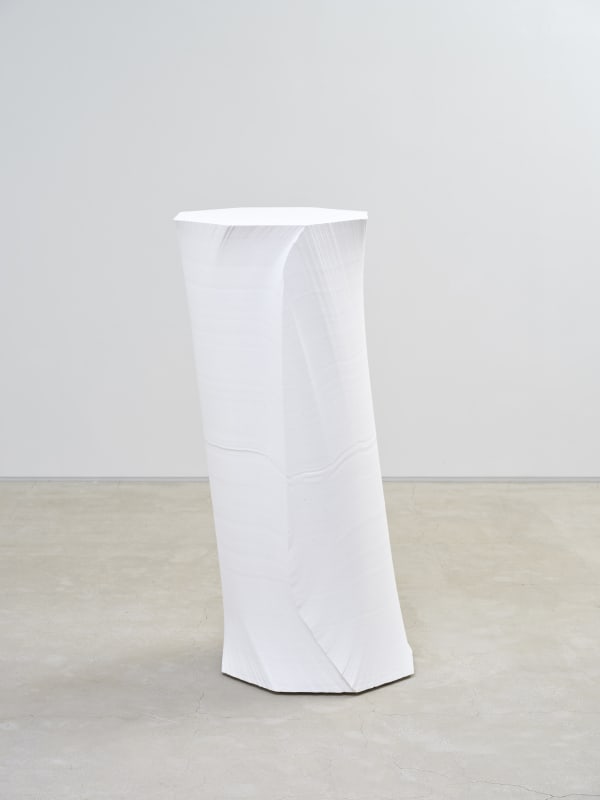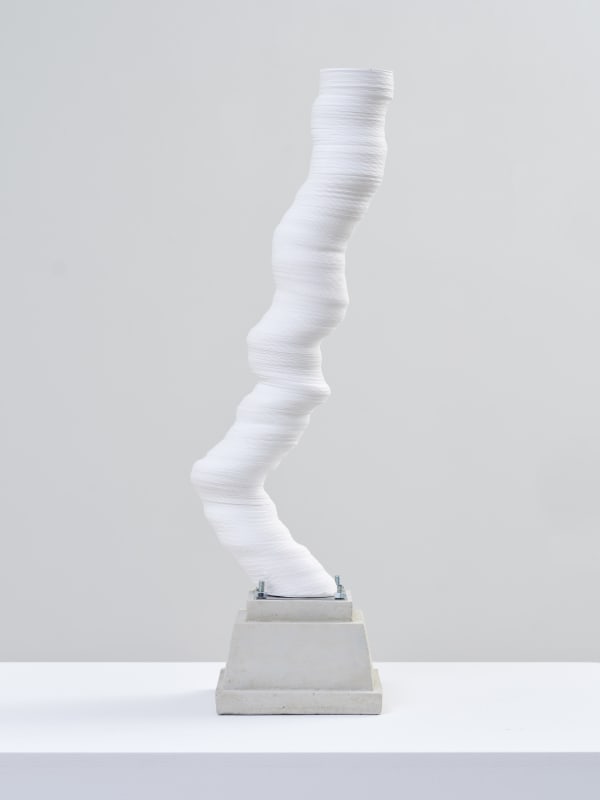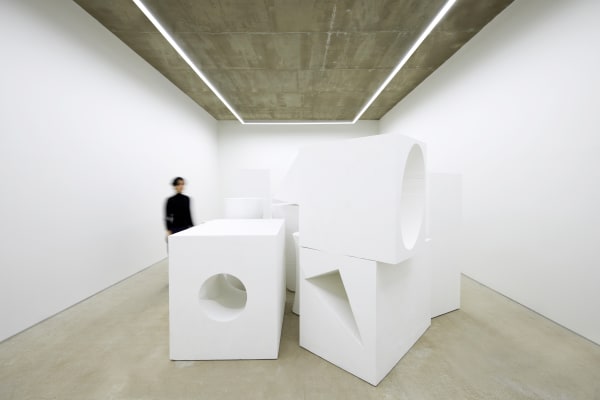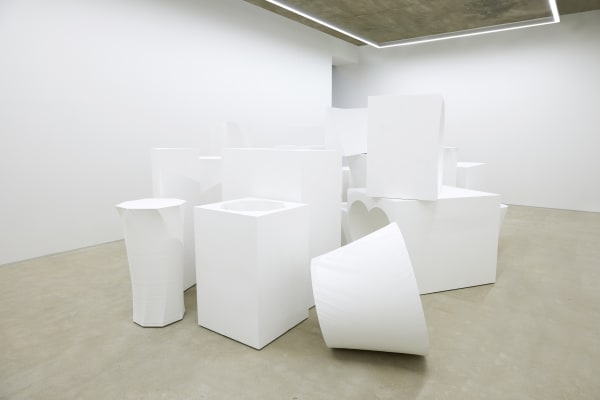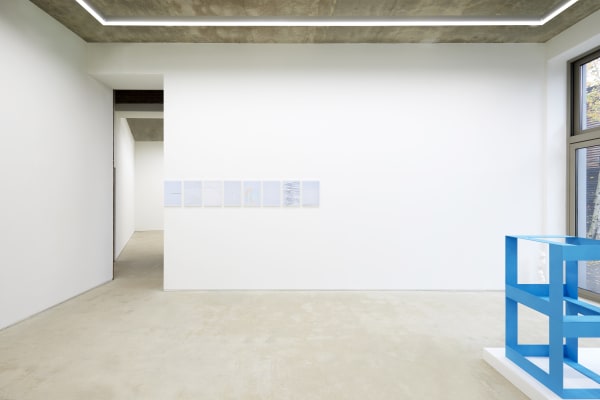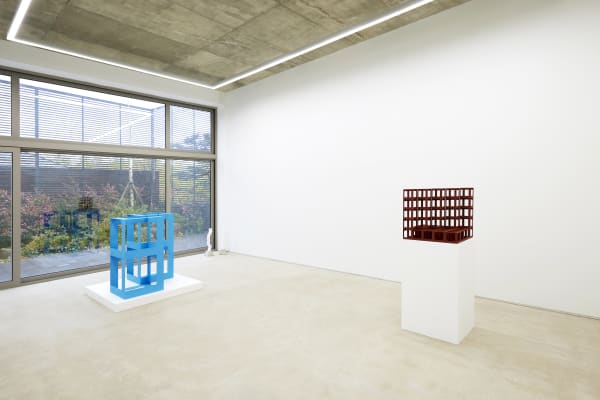수렴과 발산 Form and Variation: 김태연 Teayeon Kim
김태연의 개인전명은 <수렴과 발산 Form and Variation>이다. 수학에서는 수열의 극한이 특정 값에 가까워지는 것은 ‘수렴’, 어떤 정해진 목적지가 없이 값이 계속 바뀌는 것은 ‘발산’이라고 말한다. 이 두 단어는 단지 수학에서만 사용하는 것은 아니다. 일반적으로 하나의 근본 원리나 정답을 찾아가는 것을 ‘수렴적 사고’, 무한대로 확장하는 유연하고 자유로운 상상을 ‘발산적 사고’라고 한다. ‘수렴하지 않으면 발산한다’는 명쾌한 명제가 수학에서는 존재한다. 그러나 인간의 삶은 (수학보다 더 복잡하게도) 수렴적 사고와 발산적 사고 사이의 선택과 집중 혹은 공존을 요구한다.
작가는 규격, 제한, 제도, 조건, 한계 등 현실의 ‘틀’을 인식하고 그것을 작업의 출발점으로 삼았다. 이는 인간이 현실에서 느끼는 불만 혹은 문제점을 은유한다. 작업실 공간의 물리적 한계에 부딪혔을 때, 도구의 규격이나 제한적인 사용 범위를 넘어서고자 할 때 그는 갑자기 막연해지면서도 그 상황이 조금 흥미롭다고 말한다. 이 고정된 틀의 맹점을 찾고 또 다른 가능성이나 새로운 의미를 발견하고 맞대응 할 수 있는 대안을 제시하는 것이 김태연의 작업이다. 하지만 적극적인 저항이라고 믿었던 작업을 복기해보니 결국 자신도 틀에 의존하고 있음을 깨닫게 된다.
이번 전시에서 김태연은 그동안 탈주를 감행했던 틀의 존재를 인정했다. 작가는 고정된 틀에 그저 순응하지 않고 형태의 무한한 가능성을 보여줌과 동시에 틀이 존재한다는 사실도 티를 낸다. 그저 ‘발산’하는 다양성이 아니라 ‘수렴’되는 틀이 공존한다는 것 그리고 그것 역시 발산하는 형태 만큼이나 아름답다는 것이 작업에 내재되어 있다. 틀에 저항하는 것이 아니니 고군분투할 필요가 없다. 수렴되는 지점을 감각하고 상상하고 비틀고 다양한 견본을 만들어 낼 뿐이다. 이렇게 수렴과 발산의 새로운 관계 정립은 작가를 작품의 조형과 미감에 집중할 수 있도록 했다.
<Foam> 연작의 출발점은 표면장력으로 인해 동그란 원형 틀에서 빠져나온 다양한 크기와 모양의 비눗방울이었다. 여기서 확장된 것이 육면체 스티로폼과 그 안에서 빠져나온 도형들이다. 먼저 마주보는 면에 같은 형태의 도형을 그린다. 양 끝에서 두 사람이 협력하여 열선을 스티로폼 안으로 넣고 도형을 따라 재단한다. 하지만 기계가 아닌 수작업으로 재단을 하다 보니 두 사람 사이의 시간차로 인해 열선이 지나가는 면은 지층 같은 흔적이 생긴다. 그리고 양 끝의 도형 사이에 형태의 변형을 만들어 낸다. 도형의 모양을 따름에도 불구하고 완벽하게 통제할 수 없는 형태의 변형은 동일한 조건 안에서 발생하는 다양한 경우의 수를 은유한다. 작가는 매번 다르게 만들어지는 경우의 수에서 해방감과 희망을 발견했다. 전시에서는 도형과 육면체 스티로폼을 함께 설치했다. 마치 도형의 음각과 같은 육면체는 내부에 열선의 흔적과 틀로서의 고유한 형태를 모두 담고 있다. 이렇게 두 덩어리는 발산하는 경우의 수와 수렴되는 지점을 동시에 보여준다.
<2 by 2 Grid>와 <5 by 5 Grid>는 모눈종이의 평면 공간을 입체로 만든 작업이다. 모눈종이는 작가가 오래전부터 관심을 가져온 하나의 틀이기도 하다. ㄱ자, ㄴ자 형태의 철판을 조립한 이 작업은 어떤 지점에서는 완벽한 그리드의 형태를 갖지만 관람자의 서 있는 위치에 따라 전혀 다른 구조로 보이거나 평면의 그리드 구조에서는 인식할 수 없던 뻥 뚫린 공간을 보여준다. 그는 입체화된 그리드 공간을 통해 모눈종이의 맹점을 표현한 것이다. <수직 파도> 연작은 파형 스프링을 주형으로 해서 석고로 형태를 떠낸 작업이다. 스프링은 바닥에 세울 때마다 쓰러지지 않기 위해 매번 희한한 형태를 만들며 직립한다. 이 작업은 규격화된 기성품에서도 비결정적인 형태를 가질 수 있다는 것, 그 유연함을 드러낸다.
김태연은 일상에서 마주한 틀의 구조를 파악하고 그 안에서 뭔가 새로운 방향으로 발산할 수 있는 ‘구멍’을 찾는다. 그 뚫린 구멍을 발견할 때, 작가는 마치 숨통이 트이는 것 같다고 한다. 이는 그가 세상을 살아가는 전략이기도 하다. 자신에게 주어진 틀이 갑갑하지만 조금 돌아가면 괜찮을 거라는 마음으로 나름의 꼼수를 부르는 것이다. 작가는 예기치 못한 혹은 의도적으로 발산된 형태가 주류(규격)에 편입되지 못한 소외된 존재가 아니라 삶에 물음표를 던지고 또 다른 해석의 가능성을 갖는 담백한 존재로 비치길 원한다. 그는 오랜 고민 끝에 전시명을 <수렴과 발산>으로 결정했다. 그리고 조금 더 친절하게 <Form and Variation>이라는 영문 제목으로 ‘틀’에서 출발해서 ‘다양한’ 가능성으로 확장되고 다시 틀로 귀결되는 순환 과정을 설명했다. 둘 사이의 비율은 정확하게 50대 50이라고 한다.
Kim Taeyeon's solo exhibition is titled ⟨Convergence and Divergence: Form and Variation⟩. in mathematics, convergence is a property of approaching a limit more and more explicitly as an argument of the function increases or decreases to an extreme. On the other hand, divergence is a property of sustained change without a fixed destination. Convergence and divergence as phenomena occur outside of conceptual mathematics as well. Convergent thinking occurs when the solution to a problem can be deduced by applying established rules and logical reasoning. Divergent thinking occurs where judgment is deferred while looking for and accepting many possible solutions. There is even a clear proposition in mathematic which states, "any series that is not convergent is said to be divergent or to diverge". Yet human life is far more complex and tangled than mathematics. It requires a way of being and thought situated between convergence and divergence; select and focus or coexist.
Kim recognized real-world frames and structures in standards, restrictions, institutions, conditions, and limitations. She chose those frames to be the starting point of her work. They are metaphors for want and wanting in our reality. When she encounters physical limits of her studio, when she applies a tool beyond its intended purpose or recommended specifications for use, she finds herself bemused and amused. Kim Taeyeon explores the blind spots of these fixed boundaries and structures to seek out new shoulders to walk or meanings to explore, suggesting alternatives and means to address to what may be found. She once believed firmly that her artistic practice was pure and innocent, an antithesis of frame and structure; with time and retrospection, she found herself reliant on them.
This exhibition is a confession of sorts for Kim, acknowledging the frames that had been present in her works all along. She is not dictated by it. She displays the boundless possibility of form, and simply acknowledges that form is there. It is not a divergent diversity, but a convergent one – and both are as beautiful as the other. As there is no need for resistance, there is no struggle. She simply senses the point of convergence, then twists and imagines to create diverse converging samples. This new interrelation of convergence and divergence has provided Kim Taeyeon the means to focus on sculpture and aesthetics.
The deepest roots of ⟨Foam⟩ series are soap bubbles, blown out of a circular frame in all sizes and shapes, given the surface tension of the soap solution. What expanded here were the polystyrene foam hexahedrons (boxes) and the other geometric shapes protruding from it. First, draw identical shapes on opposing sides of the box. Two people, one on each of those opposing sides hold two ends of one hot wire cutter and follow the drawn shapes and start carving. However, this is done completely by hand and the two are not perfectly in sync. Such a cutting wire leaves behind a stratigraphic cross section, and a variation on the shape drawn on each side of the box. Despite carving along a set shape, variables cannot be entirely controlled, and form finds a way to be different. The artist discovered freedom and hope in this variation across every iteration. Polystyrene foam shapes and hexahedrons were installed together this exhibition. The counter relief-like boxes contain the stratified texture of the hot wire and the form as a mould. These two things simultaneously reveal the all-possible-outcomes of divergence and the point of convergence.
⟨2 by 2 Grid⟩ and ⟨5 by 5 Grid⟩ are a three-dimensional representation of the two-dimensional graphing paper; a frame that the artist has been deeply curious of for quite some time. The artwork was made by assembling L-shaped sheet metal. Based on the point of view, the assembly can look completely full of gaps, or something else entirely. The three-dimensional grid space is an expression of the two-dimensional blind-spot on the graphing paper. ⟨Perpendicular Wave⟩ series is a wave spring die-cast and replicated in plaster. Every time the spring is stood upright on the ground, it stands upright with an odd form as if to resist falling over. This too, is a metaphor. Something that is prefabricated to standardized specifications may still hold indeterminate form.
Kim Taeyeon identifies the underlying blueprint of the structures she encounters in life, then seeks ways to percolate right through it. She finds loopholes and whatever holes there may be to allow a new outcome. Kim describes the feeling of finding such a hole as being akin to finally getting a deep breath of fresh air after being nearly asphyxiated. This is a strategy she employs when she engages with the world. The frame she has placed upon herself may feel a bit confining, but a detour may lessen the in convenience a bit. She longs for both the unexpected and the expected forms that don't fit the norms as individuals with presence, capable of asking questions about life. Kim considered the title of the exhibition for a long time, and eventually decided ⟨Convergence and Divergence⟩ was good. She even added ⟨Form and Variation⟩ as the interpretive English title. It tells a story starting from frame to diverge into divergent possibilities. All things considered, the ratio between the convergent and the divergent is exactly fifty-fifty.
